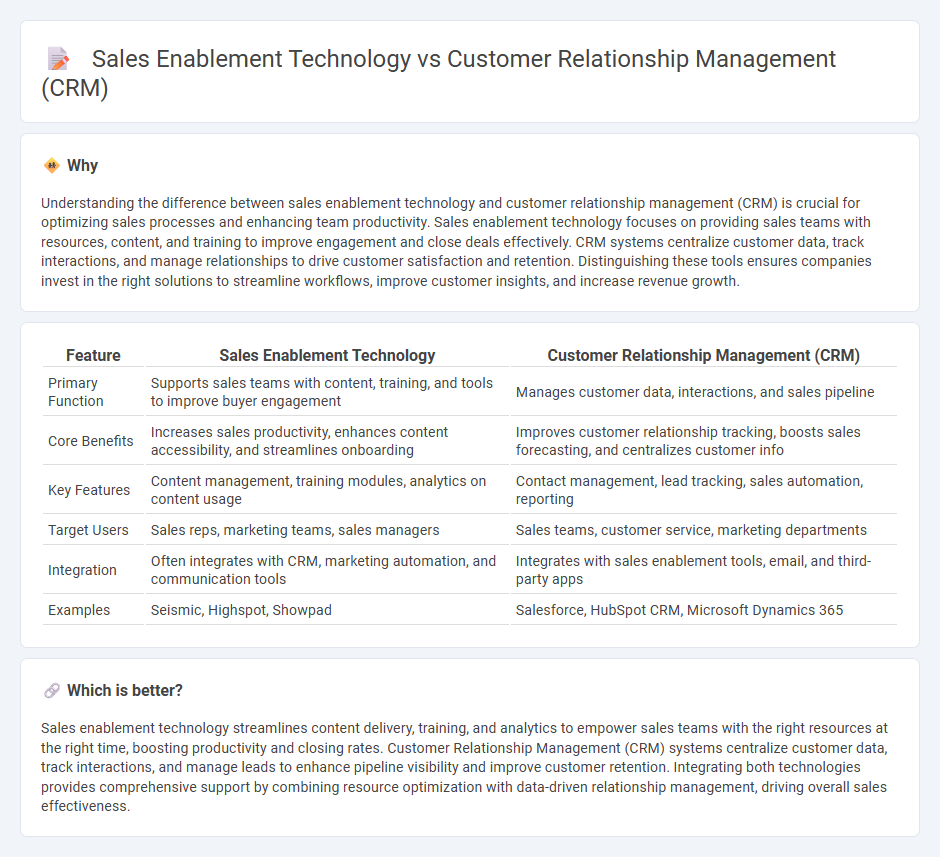
Sales enablement technology streamlines the sales process by providing tools that deliver relevant content, training, and analytics to sales teams, enhancing productivity and effectiveness. Customer Relationship Management (CRM) systems focus on managing customer interactions, tracking sales pipelines, and storing detailed client information to improve relationship management and sales forecasting. Discover how integrating these technologies can transform your sales strategy by boosting efficiency and customer engagement.
Why it is important
Understanding the difference between sales enablement technology and customer relationship management (CRM) is crucial for optimizing sales processes and enhancing team productivity. Sales enablement technology focuses on providing sales teams with resources, content, and training to improve engagement and close deals effectively. CRM systems centralize customer data, track interactions, and manage relationships to drive customer satisfaction and retention. Distinguishing these tools ensures companies invest in the right solutions to streamline workflows, improve customer insights, and increase revenue growth.
Comparison Table
| Feature | Sales Enablement Technology | Customer Relationship Management (CRM) |
|---|---|---|
| Primary Function | Supports sales teams with content, training, and tools to improve buyer engagement | Manages customer data, interactions, and sales pipeline |
| Core Benefits | Increases sales productivity, enhances content accessibility, and streamlines onboarding | Improves customer relationship tracking, boosts sales forecasting, and centralizes customer info |
| Key Features | Content management, training modules, analytics on content usage | Contact management, lead tracking, sales automation, reporting |
| Target Users | Sales reps, marketing teams, sales managers | Sales teams, customer service, marketing departments |
| Integration | Often integrates with CRM, marketing automation, and communication tools | Integrates with sales enablement tools, email, and third-party apps |
| Examples | Seismic, Highspot, Showpad | Salesforce, HubSpot CRM, Microsoft Dynamics 365 |
Which is better?
Sales enablement technology streamlines content delivery, training, and analytics to empower sales teams with the right resources at the right time, boosting productivity and closing rates. Customer Relationship Management (CRM) systems centralize customer data, track interactions, and manage leads to enhance pipeline visibility and improve customer retention. Integrating both technologies provides comprehensive support by combining resource optimization with data-driven relationship management, driving overall sales effectiveness.
Connection
Sales enablement technology integrates seamlessly with customer relationship management (CRM) systems to streamline the sales process and enhance productivity. By providing sales teams with real-time access to customer data, content, and analytics, these technologies enable personalized communication and targeted selling strategies. This connection improves lead nurturing, accelerates deal closure, and drives revenue growth through data-driven decision-making.
Key Terms
**Customer Relationship Management (CRM):**
Customer Relationship Management (CRM) systems centralize customer data, streamline communication, and enhance relationship building by tracking interactions across sales, marketing, and customer service channels. Leading CRM platforms like Salesforce, HubSpot, and Microsoft Dynamics offer customizable dashboards, automation tools, and AI-driven analytics to improve customer retention and sales forecasting. Explore how CRM technology can transform your business processes and drive growth by learning more about its features and benefits.
Lead Tracking
Customer Relationship Management (CRM) systems centralize lead tracking by aggregating customer data, interaction history, and communication logs to streamline sales processes and improve relationship management. Sales enablement technology enhances lead tracking by equipping sales teams with targeted content, analytics, and real-time insights to accelerate lead qualification and engagement. Explore how integrating CRM and sales enablement tools can optimize your lead tracking and boost conversion rates.
Contact Management
Customer relationship management (CRM) systems excel in comprehensive contact management by centralizing customer data, tracking interactions, and segmenting contacts for targeted marketing. Sales enablement technology complements CRM by providing tools that enhance sales engagement, such as content sharing and real-time communication insights linked to contacts. Explore how integrating both technologies can optimize your contact management strategy and boost sales performance.
Source and External Links
What is CRM (Customer Relationship Management)? - CRM combines practices, strategies, and technologies to manage and analyze customer interactions throughout the customer lifecycle, improving customer service relationships and driving sales growth.
What Is CRM? | IBM - CRM is a set of integrated technologies used to document, track, and manage an organization's relationships and interactions with existing and potential customers.
What is CRM (Customer Relationship Management)? - CRM helps companies track and drive revenue while maintaining and improving customer relationships by capturing and managing customer interactions across multiple channels.
 dowidth.com
dowidth.com